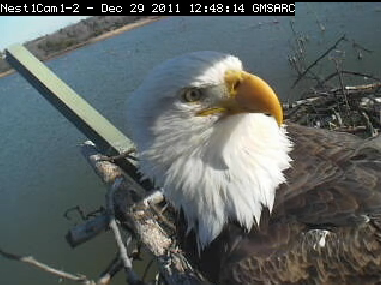Yes kitten. The cam can pan.
Beth, the screencaps are wonderful. Here's another from earlier in the day.

.
This history posted by Pat B on Sept 29, 2010 at Hancock Forum.
Until 2010, the pair nested on an artificial tower erected by the Sutton Avian Research Center and local utility OG&E to replace the original dead nest tree used by this pair after it fell down. The pair first built a nest in the dead tree in 1995, and laid their first eggs in 1996. Since then, they've fledged 24 eaglets, with three eaglets in 2000 and 2002. 2008 was the first year they've known how many eggs were laid; they do know that three eggs hatched in 2007, but the youngest chick was unable to compete for food with its older siblings, so only two of them fledged. There were four eggs laid in 2008, but the cam was down for a month shortly after they started to hatch, so we don't know how many of them hatched; there were two eaglets when the cam came back, and both fledged successfully. There were three eggs laid in 2009, and one hatched; the eaglet fledged successfully at about 12-1/2 weeks, and was seen in the area until it was about 19 weeks old. In 2010 the moved from the artificial tower and, after apparently trying a few nearby locations, settled on an old hawk nest in a dead cottonwood tree. They managed to do some work on the nest, but it was still quite a bit smaller than the average eagle nest, with some rickety areas and a few holes when they laid their three eggs. It was a sad year - one of the eggs didn't hatch; the younger chick fell from the nest and died when it was two days old, possibly after being blown into an unfinished area near the edge by gusty winds; and the remaining chick fell from the nest and died when it was 36 days old; analysis by the Sutton Center suggests it may have backed up to the edge of the nest for a poop shot, lost its balance, and stepped backwards over the relatively low edge of the nest as it tried to recover.



